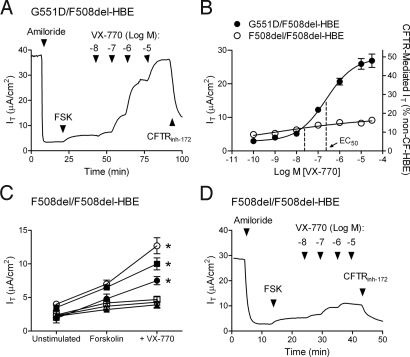Fig. 3.
VX-770 potentiated CFTR-mediated Cl− secretion in primary cultures of G551D/F508del HBE and F508del HBE. Ussing chamber techniques were used to record the IT resulting from CFTR-mediated Cl− secretion. To isolate the CFTR-mediated IT, a basolateral to apical Cl− gradient was established, 30 μM amiloride was added to block ENaC, and 10 μM (EC99) forskolin (FSK) was applied to activate CFTR. The addition CFTRinh-172 (20 μM) to the apical surface was used to confirm that the forskolin-stimulated IT was caused by CFTR. (A) Representative IT tracing from G551D/F508del HBE. (B) The concentration–response curve for VX-770 in the presence of FSK is shown for G551D/F508del HBE isolated from the bronchi of a single individual (filled circles; n = 16) and F508del HBE isolated from the bronchi of the three individuals that responded to VX-770 (open circles; n = 7–24). Left y axis shows IT responses; right y axis shows IT normalized to the 10 μM FSK-stimulated IT in non-CF HBE (mean ± SEM). Note that the error bars for the F508del HBE were smaller than the symbol. (C) The IT before FSK addition (unstimulated) and during the sequential addition of 10 μM FSK followed by 10 μM VX-770 in F508del HBE isolated from the bronchi of six F508del-homozygous individuals (n = 4–24). (D) Representative IT tracing from F508del HBE isolated from the bronchi represented by the open circles in C.

